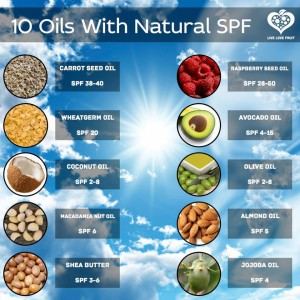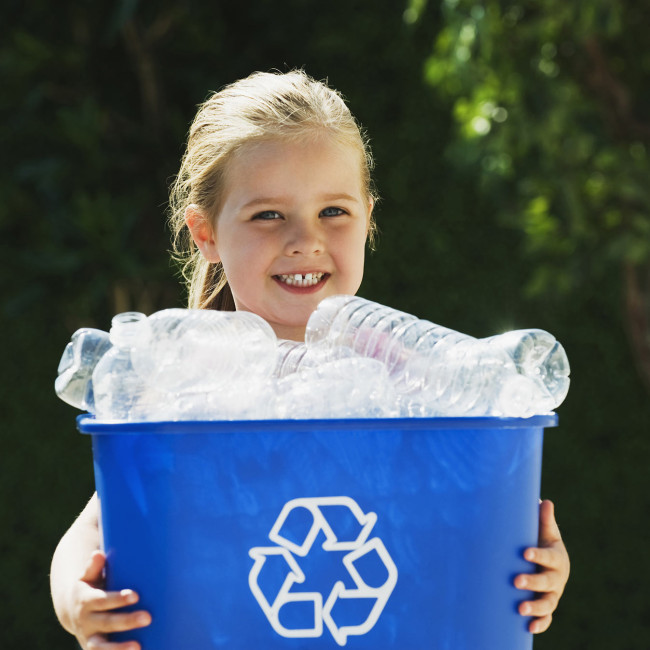We at OLM are not fans of sunscreen or sunblock. The problem is that we have not found a totally safe and benign topical way to protect the skin from sun damage besides coverage with clothing and hats.
Sunlight has numerous health benefits including the most well known, vitamin D. Most of us do not get enough vitamin D. And anyone who eats well and is in relative good health can enjoy sunlight. As with everything else having to do with health, believe it or not, a healthy diet full of a wide variety of organic, nutrient dense fresh produce is the very best way to prevent, heal, and reverse premature aging, damage, and skin cancers that can be caused by the sun.
Simply limiting exposure to shorter periods until the skin builds up its natural defenses is the best way to be able to play in the sun without the worry of sun damage. But we live in the real world, and not everyone has time to build up the their sun tolerance for a week in order to enjoy 8 hours at the beach with nothing more than a swimsuit.
Exaggerated Dangers of Sunlight
When we first learned about the dangers of too much sun exposure, we ignored the dangers of not enough sun exposure, which as it turns out, leads to greater incidents of cancer, including the more dangerous form of skin cancer.
“There are two types of skin cancer,” says Dr. Michael Holick, one of the world’s leading authorities on vitamin D and vitamin D deficiency. “There’s what’s called non-melanoma skin cancer and there is no question that excessive exposure to sunlight and sunburns will damage the DNA and induce skin cells to become cancerous. That is non-melanoma squamous and basal cell cancers. They are typically easy to detect, easy to treat. They’re not lethal, for the most part.
“Melanoma is a different story. Most melanomas occur on the least sun exposed areas. Occupational sun exposure decreases your risk of malignant melanoma.”
And to top it off, vitamin D, what you get from our vilified sun, is one of the best preventers of any and all types of cancer!
For more on sunlight, skin cancer, and vitamin D, check out our article, Sunlight and Vitamin D.
Dangers of Sunscreens
So we all got scared of skin cancer, and what did we do? We started slathering on toxic chemicals that kept our skin from appearing and feeling burned while we sunbathed . Thinking we were totally protected, we cooked these chemicals into our skin, causing serious damage to out skin, our liver, our DNA, etc.
And guess what happened? Skin cancer rates rose right along with the use of sunscreen.
Canada Proposes Stricter Sunscreen Regulations
If Canada’s planned rules take effect, this would likely prompt much needed changes in the sunscreens sold in the United States.
“Sunscreen companies won’t make better products until they are forced to,” said Sonya Lunder, Senior Analyst at Environmental Working Group. “EWG welcomes Canada’s efforts to improve sunscreen protection, particularly because the U.S. Food and Drug Administration appears unable or unwilling to wrap up its sunscreen rules more than thirty years in the making.”
For more on Canada’s Stricter Sunscreen Rules, checkout The Environmental Working Group’s article.
EWG
The Environmental Working Group has just released its 7th annual Sunscreen Guide.This guide rates the safety and efficacy of over 1,400 sunscreens, lotions, lip products and makeups that advertise sun protection.
“The vast majority of sunscreens available to the consumer aren’t as good as most people think they are, but there are a handful of products that rise above the rest,” said Sonya Lunder, senior research analyst at EWG and lead author of the report. “The best advice for concerned consumers is to use sun-protective clothing, stay in the shade to reduce intense sun exposure, and schedule regular skin examinations by a doctor. And turn to EWG’s guide to find the best sunscreens for skin that isn’t protected by clothing.”
“Despite an increasing awareness of the sun’s risks, rates of melanoma – the deadliest skin cancer – have tripled over the past 35 years, with an annual increase of 1.9 percent per year since 2000,” Lunder said.
The Environmental Working Group states, “Part of the reason for the increase may be the decades of deceptive marketing claims by sunscreen manufacturers, EWG researchers said. EWG believes that the federal Food and Drug Administration should press companies to stop selling high-SPF sunscreens (above 50+), which account for 1 in 7 products on the market. As a result of misleading and confusing marketing claims, consumers frequently misuse sunscreens and spend more time in the sun than they should, putting themselves at greater risk.” We contend that that sunscreen’s toxic chemicals are the biggest culprit.
Sunscreen Ingredients to Avoid
Retinyl Palmitate: In sunscreen, exposed to the intense rays of the sun, Retinyl Palmitate builds up in the skin elevating the risk of skin cancer and other health issues.
Oxybenzone: Also known as methanone, 2-hydroxy 4 methoxydenzophenone and benzophenone-3. The Environmental Working Group states that 56% of sunscreens contain Oxybenzone, a penetration enhancer (causes other chemicals to be able to penetrate skin). This chemical is known to cause allergic skin reactions that can spread beyond applied areas. Oxybenzone disrupts the human endocrine system and can damage the cardiovascular system.
Octinoxate: The most widely used sunscreen ingredient, octinoxate helps other ingredients be absorbed more readily. Studies show that this chemical is likely responsible for disrupting the endocrine system by altering hormones. The chemical’s effects on estrogen levels are harmful for humans and our environment. Octinoxate is likely the main culprit for premature aging due to the fact that it produces free radicals that attack and damage our skin cells.
Benzophenone-3 (B-3): Can damage DNA.
Amino Benzoic Acid: Otherwise known as PABA, para-aminobenzoic acid, Vitamin Bx or padimate O, Amino Benzoic Acid is a nontoxic UV filtering compound. But researchers have come to find that Amino Benzoic Acid can amplify cellular damage.
Homosalate: Like oxybenzone, homosalate can mimic bodily hormones. Our bodies cannot remove this chemical at the common rate of absorption so it accumulates to very toxic levels over time.
Paraben Preservatives: There have been many reports of serious chronic and acute side effects associated with Paraben preservatives. Derived from plant and petroleum sources, these preservatives may cause irritation and allergic reactions. More importantly, the chronic effects of Paraben use are known to disrupt and mimic hormones and cause reproductive toxicity. As a suspected carcinogen, it has connections with breast tumors, skin cell damage, and oxidative stress on the body’s tissues, according to the National Institute of Standards and Technology.
Octocrytene: This synthetic UV absorber may produce oxygen radicals that cause cell mutation resulting in increased production of free radicals that are known to damage DNA, which may lead malignant melanoma skin cancer.
Artificial Ingredients: Scents, colors, and preservatives are never good to put on your skin. They are absorbed into your body, and when baked in the sun, many of these ingredients can become even more dangerous,. Like, for starters, many artificial ingredients when cooked into the skin produce DNA damaging free radicals. These artificial ingredients are bad for us, bad for the environment, and should be avoided anywhere, in food, sunscreens, supplements, etc.
The Safest Effective Active Sunscreen Ingredient
While there are many totally natural, completely safe, and edible ingredient options that offer some protection from the sun, the highest SPF you can get from them is about a 5 (see our homemade recipe below). But for a higher level of sunburn protection, we choose zinc oxide. Not the nano technology kind which is composed of zinc oxide particles so small they are absorb into the skin. You don’t want to absorb zinc oxide. And if you’re healthy, you shouldn’t absorb any non nano zinc oxide applied to the skin. It’s still not the kind of thing we want to put on our body. But for any significant SPF protection, it’s the best choice we know of.
For more on zinc oxide, check out this post by The Environmental Working Group.
Raspberry seed oil has an SPF of 25-50!
Homemade Sunscreen
It’s easy to make your own sunscreen. But how effective is it? There are some efficacy issues to consider. And be careful. Don’t just slather on some coconut oil with zinc oxide and then spend 8 hours in the sun.
Homemade Sunscreen Warning
Before deciding to save a few dollars with the DIY route, consider some of the issues that arise when making your own sunscreen.
One problem with making your own sunscreen at home is that there is no effective way to test SPF levels. Another issue is mixing the ingredients. Sunscreen manufacturers use a high pressure machine called a homogenizer to break up zinc and/or titanium dioxide particles in order to evenly distribute them throughout he formulas. Mixing by hand, or even a blender can cause uneven distribution of the active ingredients leaving large areas of skin partially or totally exposed to UV rays.
And oils by themselves can actually contribute to sunburns by absorbing light which allows greater UV ray penetration. It should also be noted that store-bought sunscreens typically contain a of different ingredients to protect against the different wavelengths of UV rays. Zinc or titanium dioxide alone does not offer the same level of protection from sunburns.
That said, we still choose sunburn over cancer causing chemicals any day! And we are a fan of DIY projects. But regardless, when using sunscreen, and especially the homemade variety, use common sense with sun exposure. Reapply after getting wet. Use a hat and cover the body after or get out of the sun all together before you burn.
How to Make Homemade Organic Sunscreen
- 1/4 cup of aloe vera gel
- 1/4 a cup of coconut oil
- 1/4 cup of raspberry seed oil
- 5 tablespoons Shea Butter
- ¼ cup Beeswax
- 5 tablespoons Zinc Oxide
Coconut oil and shea butter are natural sunscreens (around SPF 5). The beeswax helps make lotion water resistant. Aloe moisturizes and protects against burns. Raspberry seed oil has an SPF of 25-50.
Zinc Oxide must be only zinc oxide and should not be nano particle technology (it should not be able to be absorbed through the skin). Be careful not to inhale!
Optional Ingredients – Antioxidants
- Green Tea (brew concentrated green tea and add ¼ a cup)
- 3 tablespoons of Vitamin E oil
- 10 drops Grapefruit Seed Extract
You can also add essential oils for scent, but avoid citrus as citrus oils can contribute to sunburns.
Instructions
Combine all ingredients except zinc oxide and heat until ingredients liquefy. You want ingredients to melt but not cook or become too hot for the next step, so watch closely and pull as soon as liquefied. We recommend a double boiler for this. You can also put the ingredients into a jar and put the jar into a pot of hot water on the stove at a higher setting.
Put ingredients into a blender with zinc oxide (the better quality the blender the better this will work) and blend with zinc oxide. If you don’t have a blender (or you have a cheap one that doesn’t mix well) then see above warnings.
Mix on highest setting until all ingredients are thoroughly mixed and then pour the solution into the container you will use to store it. A pump container isn’t going to work very well for this. I recommend a mason jar.
Now place the product in the freezer for about 20 minutes. This will solidify the product so that the ingredients stay evenly mixed and don’t separate. Then put product in the refrigerator.
Keeping the product cool keeps the ingredients from separating. This allows us to have a more stable product without the use of the chemicals manufacturers have to resort to keep their product ingredients evenly distributed.
When ready to use, you can scoop some out and put into a smaller container to take with you, or put the whole thing in a cooler with your picnic.
And play with the recipe. Depending on the product consistency and the temperature you keep it at, you may find that varying some of the ingredients work better for you.
Application
If you know you’re going to be needing sun protection the next day, we recommend applying sunscreen liberally the night before and the morning or for greatest efficacy.
Notes
This recipe has an SPF of around 30. More or less Zinc Oxide will increase or decrease the SPF. It is water resistant, but if you sweat or swim do reapply.
More beeswax makes thicker sunscreen, less makes thinner. We like thicker to reduce ingredients settling and separating.
Remove the zinc oxide and you’ve got an amazing lotion that has a little bit of sun protection as well.
And for truly organic sunscreen, and a totally edible sunscreen (a light sunscreen with a low SPF), remove the zinc oxide and make sure all ingredients are 100% organic.
And here is an infograph we just came across from livelovefruit.com. Let us know if you try some of these oils!
 Best Sunscreen
Best Sunscreen
We like Solar Body Block 30+ by DeVita Professional Skin Care. It’s vegan, cruelty free, paraben free, titanium dioxide free, and has been tested and proven to be of SPF level 32. We liked it, so we got it for our store at Green Lifestyle Market.
https://www.greenlifestylemarket.com/solar-body-block-30-7oz-devita-professional-skin-care
You can check out the Environmental Working Group’s listing of Solar Body Block 30+ here
We Want to Hear From You
What, if anything, do you do for sunburn protection? Do you have any sunscreen recipes or ways to improve our recipes? Did you have any luck with the homemade sunscreen recipe or some of the oils listed?

 Getting kids involved in the food that comes into the house naturally improves their food choices, thus reducing the risk of obesity. Further, teaching kids to garden and allowing them to choose what vegetables they would like to grow, encourages healthy eating habits and a dedication to locally grown, seasonal foods.
Getting kids involved in the food that comes into the house naturally improves their food choices, thus reducing the risk of obesity. Further, teaching kids to garden and allowing them to choose what vegetables they would like to grow, encourages healthy eating habits and a dedication to locally grown, seasonal foods.